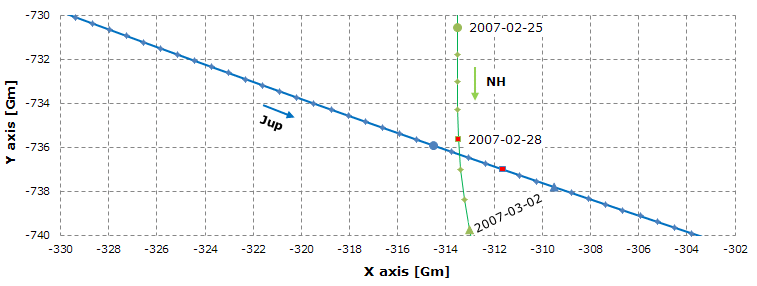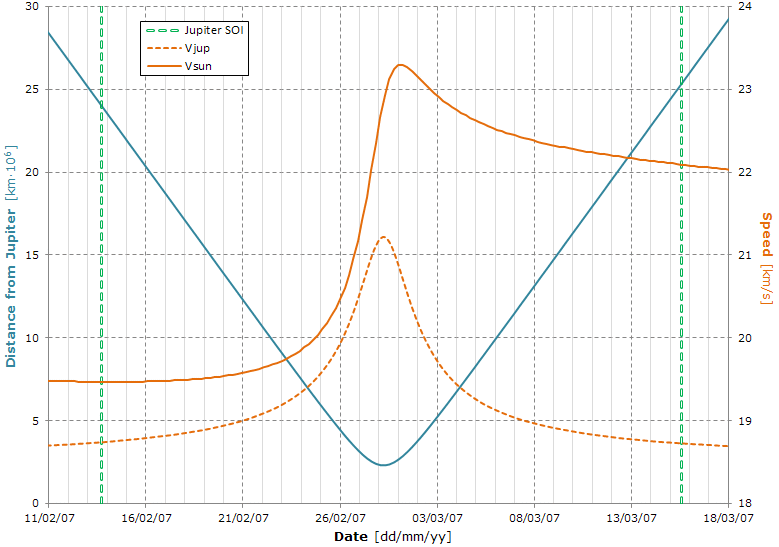New Horizons - Jupiter flyby

The graph shows the geometry of the New Horizons - Jupiter flyby in the heliocentric mean ecliptic and equinox of J2000 reference frame (the Sun position is x = 0, y = 0).
The Jupiter orbital speed is about 12.7 km/s, while the NH initial heliocentric orbital speed (near the green circle) is about 20 km/s.
The filled circles indicate the position of both NH and Jupiter on Feb 25. The dots represent the positions obtained from the data files with step size of 60 000 s.
After 3 dots, there is a red filled square that represents the NH periapsis (notice the variation in the NH direction).
Here's a 3D version of the previous graph in the Jupiter-centered mean ecliptic and equinox of J2000 reference frame.
Black dots: NH position. The popup label shows the UTC time, the NH radius vector (Djup, million kilometers), the NH speed wrt Jupiter (Vjup, km/s) and the heliocentric NH speed (Vh, km/s).
Black orbit arc: Callisto position during flyby (just for reference). The popup label shows the UTC time, Callisto radius vector (Djup, million kilometers), the distance between Callisto and NH (D
NH, million kilometers). At the time of the NH periapsis, Callisto was in opposition wrt Jupiter as seen from the NH.
Orange line: Jupiter heliocentric velocity vector at the time of the NH periapsis.
Yellow line: Sun direction at the time of the NH periapsis.
Jupiter is shown as an ellipsoid with radii 71 492 km and 66 854 km.

Here's the distance between NH and Jupiter (blue plot), the NH speed wrt Jupiter (dashed plot) and wrt the Sun. The green vertical lines represent the Jupiter sphere of influence (the distance from Jupiter where the gravitational acceleration of Jupiter and of the Sun are the same).
The NH periapsis was about 2.3 million kilometers.
The NH speed wrt the Sun increased from about 19.5 km/s before the SOI to about 22 km/s after the SOI.
New Horizons - Pluto flyby
Here's the Pluto flyby in the Pluto-centered mean ecliptic and equinox of J2000 reference frame.
Black dots: NH position. The popup label shows the UTC time, the NH radius vector (Dplu, km), the NH altitude above Pluto (h, km), the NH speed wrt Pluto (Vplu, km/s) and the heliocentric NH speed (Vh, km/s).
Orange line: Pluto heliocentric velocity vector at the time of the NH periapsis.
Yellow line: Sun direction at the time of the NH periapsis.
Since Pluto is modeled as a sphere with radius 1188.3 km, the NH altitude is simply calculated as Dplu - 1188.3.
The adopted value of the Pluto radius is the recommended value found in the paper
Mean radius and shape of Pluto and Charon from New Horizons images table 6 (pdf, 1.5 MiB).
 The graph shows the geometry of the New Horizons - Jupiter flyby in the heliocentric mean ecliptic and equinox of J2000 reference frame (the Sun position is x = 0, y = 0).
The graph shows the geometry of the New Horizons - Jupiter flyby in the heliocentric mean ecliptic and equinox of J2000 reference frame (the Sun position is x = 0, y = 0). Here's the distance between NH and Jupiter (blue plot), the NH speed wrt Jupiter (dashed plot) and wrt the Sun. The green vertical lines represent the Jupiter sphere of influence (the distance from Jupiter where the gravitational acceleration of Jupiter and of the Sun are the same).
Here's the distance between NH and Jupiter (blue plot), the NH speed wrt Jupiter (dashed plot) and wrt the Sun. The green vertical lines represent the Jupiter sphere of influence (the distance from Jupiter where the gravitational acceleration of Jupiter and of the Sun are the same).